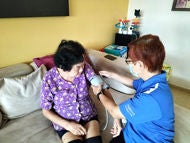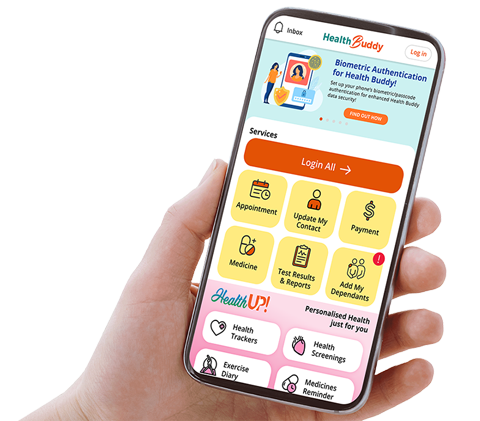
Mr Savio Wong struggled with urinary issues and had to plan his days around toilet access before undergoing a minimally invasive procedure in January 2025.ST PHOTO: CHONG JUN LIANG
SINGAPORE – For years, Mr Savio Wong struggled with urinary problems that disrupted his daily life.
At 49, he began waking up every two to three hours at night to urinate, felt pressure and pain in his urinary tract, and often had to force his urine out.
After visiting a general practitioner, he was told it could be benign prostatic hyperplasia (BPH). This is also referred to as an enlarged prostate – a non-cancerous increase in the size of the prostate gland that can block the flow of urine and cause a range of urinary issues in men, especially as they age.
“I didn’t expect it to come so early,” says Mr Wong, now 55, as his father had the same condition in his 80s.
Mr Wong, who is a business development director in the broadcasting industry, was referred to Tan Tock Seng Hospital, where the diagnosis was confirmed.
The doctor said it was the first stage of BPH and that surgery was not yet necessary. Instead, he was prescribed oral medication to relieve the pressure from the prostate. “My condition became stable after I took the medication,” says Mr Wong, who continued to visit the hospital every six months to a year for follow-ups.
In 2021, he was referred to Ng Teng Fong General Hospital (NTFGH), where he underwent regular urine tests to monitor urinary flow and bladder function, and blood tests to check for prostate cancer.
But by 2024, the effectiveness of the medication had begun to wane.
“I started facing issues with my urine flow again. I was starting to force my urine out,” he says.
“One of the side effects from taking the medication was dizziness. The dizziness had become more annoying. Sometimes, I also felt very lethargic,” says Mr Wong, who is married and has no kids.
Though the medication initially helped relieve symptoms, the condition still significantly affected his quality of life. He had to plan his days around toilet access.
“I had to go to the toilet every few hours. Even though it was less often (compared with before taking medication), it was still considered frequent,” he says.
“When I travelled, I couldn’t go to places without toilets. For example, I couldn’t go hiking. My travels had to be in the city.”
At one point, he considered wearing diapers, in case he could not find a toilet in time.
Mr Wong’s experience is far from rare.
Growing concern among ageing men
Dr Edwin Aslim, consultant at Singapore General Hospital’s department of urology, says BPH is the most common condition in urology, accounting for 15 to 20 per cent of all patients seen in the clinic.
At NTFGH’s urology division, Dr Tan Yi Quan, an associate consultant, notes that about half of his patients above the age of 50 have BPH.
“The condition is very common, affecting 50 per cent of men by the time they are 51 to 60 years old,” he says.
Dr Tan expects the number of BPH cases in Singapore to rise, given the country’s rapidly ageing population.
“According to global data, the main group of BPH patients is between 65 and 75 years old. At the same time, one-third of patients are below the age of 65, so that’s a big group as well,” he says.
Age is the main risk factor, but other factors, such as diabetes, obesity and metabolic syndrome, have also been associated with an increased risk of prostate enlargement.
Condition affects quality of life
The symptoms of BPH can significantly impact a man’s quality of life, affecting daily activities, sleep, psychological health, sexual health and work.
Dr Tan says he has had patients whose anxiety about their urinary symptoms made them fear travelling, playing sports or watching movies. Some have had their work productivity affected, especially drivers or those working long shifts.

Dr Tan Yi Quan (left), associate consultant at Ng Teng Fong General Hospital’s urology division, with his patient Savio Wong, who underwent the Temporary Implantable Nitinol Device procedure to treat his enlarged prostate.ST PHOTO: CHONG JUN LIANG
Dr Edwin says he commonly sees men in their 60s complaining of frequent urination, especially in cooler weather, waking up three to five times at night to urinate, and taking longer to finish urinating.
“Their urine flow is slower in the mornings, and they sometimes need to strain. Many also feel their bladder is not fully emptied,” he says.
Because they often feel a strong and sudden urge to urinate, they worry about getting to a toilet during long bus rides or traffic jams. They would often limit their fluid intake to reduce the need to go to the toilet, says Dr Edwin.
A diagnosis of BPH is first based on lower urinary tract symptoms and is confirmed by further tests, including an ultrasound scan assessment of the prostate, urinary flow measurements, digital rectal examination and a blood test.
Dr Edwin adds that BPH symptoms often resemble those of prostate cancer, which is why further tests are needed to rule out cancer in all men with urinary issues.
Some “red flag” symptoms that can indicate a more serious urological condition include blood in urine, painful urination, lower abdominal or bladder pain, and urinary incontinence.
Medication is often the first line of treatment for BPH, says Dr Tan, with options that either relax the muscle fibres of the prostate, or shrink the prostate, to improve urinary flow.
Surgery may be recommended if a patient develops complications, or has minimal improvement or significant side effects while on medication.
Issues with medication
In Mr Wong’s case, his medication had worked initially, but became less effective over time and came with unpleasant side effects such as dizziness and fatigue.
In early 2024, Dr Tan laid out several minimally invasive surgical options. Mr Wong opted for the Temporary Implantable Nitinol Device procedure.

Dr Tan Yi Quan (right), associate consultant at Ng Teng Fong General Hospital’s urology division, explaining the Temporary Implantable Nitinol Device procedure to Mr Savio Wong.ST PHOTO: CHONG JUN LIANG
It is a new, minimally invasive surgical therapy for BPH that has been available in Singapore since May 2024, says Dr Tan.
During the procedure, a cystoscope is used to guide the placement of a small metal device into the prostate through the urethra, where it reshapes the prostate tissue and widens the urinary passage.
The device stays in place temporarily for five to seven days and is then removed.
The procedure is typically performed using a rigid cystoscope – a straight camera tube that allows the urologist to view the urinary tract and insert the device.
According to Dr Tan, who did the operation in January, Mr Wong was the first patient in Singapore to successfully undergo the procedure using a flexible cystoscope, which is gentler on the urinary tract.
Four-minute procedure turned life around
“The procedure itself took four minutes. Most cases are performed under sedation and as day-surgery cases,” says Dr Tan.
Mr Wong chose to stay in the hospital for a day before getting discharged. The implant was removed five days later under local anaesthesia.

Dr Tan Yi Quan, associate consultant at Ng Teng Fong General Hospital's urology division, demonstrating how the Temporary Implantable Nitinol Device works on the prostate.ST PHOTO: CHONG JUN LIANG
The procedure, Dr Tan says, helps improve urine flow and quality of life, and relieve symptoms without cutting, burning or removing prostate tissue. It has minimal complications and impact on sexual function.
Recovery was almost immediate.
“The improvement after the operation was also very fast,” says Mr Wong. “Now, I can hold my urine. There’s no urgency to go to the toilet. The symptoms I had for years have disappeared.”
Apart from the Temporary Implantable Nitinol Device procedure, there are other minimally invasive procedures to treat BPH in Singapore, such as water vapour therapy and prostatic urethral lift.
In water vapour therapy, steam is injected into the enlarged prostate tissue.
The heat from the steam destroys prostate cells, shrinking the prostate, thereby relieving pressure on the urethra and improving urine flow.
In prostatic urethral lift, small permanent implants are placed to lift and hold prostate tissue apart, hence improving urinary flow.
While medication and surgery are key options for managing BPH, lifestyle modifications also play a role in alleviating symptoms.
Exercise, for instance, can boost the overall physical health and fitness of the body, and can improve the symptoms of BPH.
A balanced diet rich in fibre, vitamins and minerals may help slow the progression of BPH, says Dr Edwin.
For men with mild symptoms, cutting back on caffeine – found in coffee and tea – can reduce the sudden, strong need to pee.
Dr Tan also cautions against the misconception that BPH increases the risk of prostate cancer.
“The risk of developing both BPH and prostate cancer increases with age, but BPH itself is non-cancerous and does not lead to prostate cancer,” he says.
For Mr Wong, the choice to go for minimally invasive surgery has given him relief and freedom.
“I always had to find out where the nearest toilet was,” he says. “But now, for the first time in years, I no longer plan my life around my next trip to the bathroom.”
The Straits Times, Singapore Press Holdings Limited. Reproduced with permission
Contributed by




















